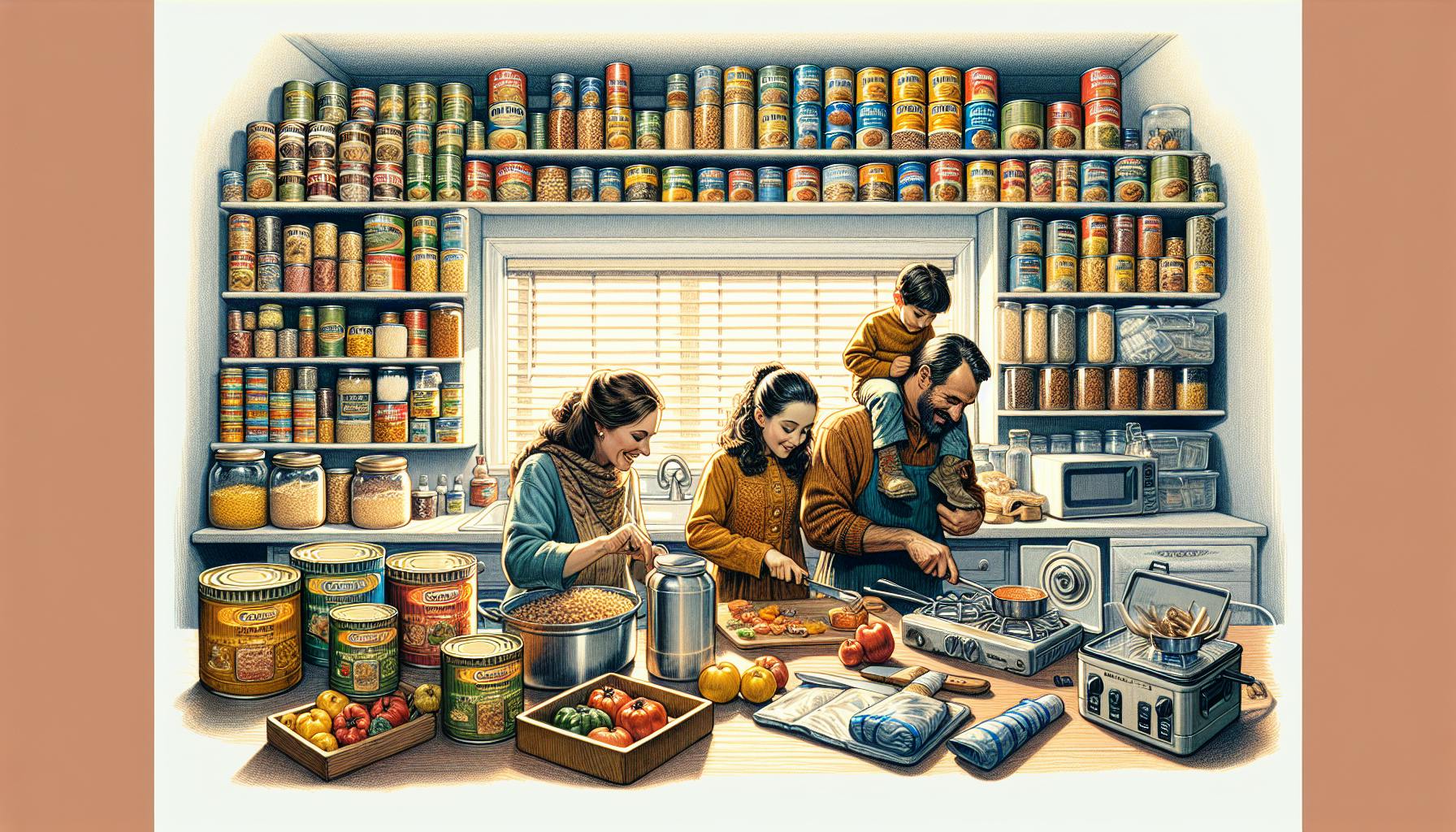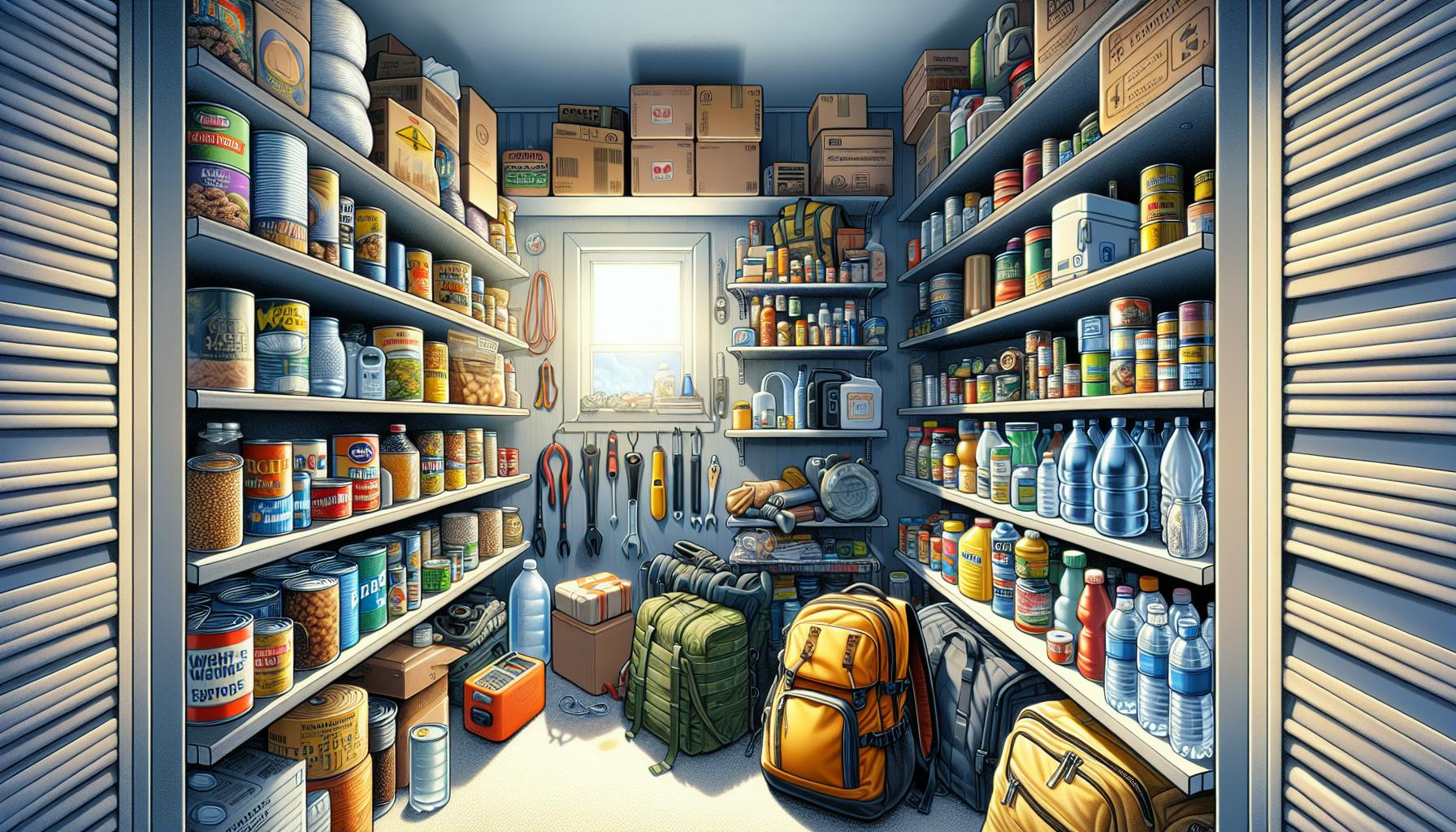Preparing for emergencies starts with having the right supplies. We can all agree that food is among the most vital items when crisis strikes.
This comprehensive guide provides tailored strategies for building a resilient stockpile that meets your household's unique dietary needs.
You'll get step-by-step instructions for creating a custom prepper food checklist covering everything from budget-friendly essentials to specialized considerations for infants, pets, and restrictive diets.
Introduction to Prepper Food Essentials
Having the right foods stockpiled can make a crucial difference in an emergency. This article provides tips on creating a comprehensive prepper food checklist tailored to your family's needs.
Understanding the Basics of Emergency Preparedness
Being prepared for emergencies requires having supplies like food, water, first aid kits, flashlights, and radios. Stockpiling non-perishable foods ensures you have nutrients to sustain energy levels during a crisis. Rotate and replace food before expiration dates. Store at least a 3-day supply, gradually building up to 2 weeks or more.
The Importance of a Food Stockpile Checklist
A detailed checklist helps you methodically build an emergency food supply. It ensures you get appropriate nutrition, track expiration dates, and rotate stock. List key categories like grains, proteins, fruits and vegetables. Identify ideal storage conditions. Update as family needs change.
Setting Up Your Prepper Pantry: A Step-by-Step Guide
- Take inventory of current emergency food supply
- Research recommended items to stockpile
- Create checklist categorized by food groups
- Purchase items, focusing on shelf life, portability
- Organize storage area, label containers
- Establish rotation system to use older items first
- Set reminders to check dates and replace expired foods
Budget-Friendly Strategies for Building Your Prepper Food Supply
- Buy shelf-stable items in bulk quantities when on sale
- Look for coupons, loyalty programs, or bulk food stores
- Substitute some canned goods with economical dry goods
- Grow your own fruits/vegetables when possible
- Split large quantity purchases with other preppers
Essential Considerations for a Balanced Prepper Diet
When building your stockpile, ensure variety and nutritional balance across categories:
- Proteins: Canned meats, beans, nuts
- Grains: Rice, oats, pasta, flour
- Fruits & Vegetables: Canned or pouched produce
- Dairy: Powdered milk, shelf-stable milk
- Comfort Foods: Honey, peanut butter, spices
Tailor your prepper food supply to meet your household's unique dietary needs and preferences. Maintain an organized emergency pantry with a rotation system. Update and replace items regularly to sustain readiness.
What foods should I stockpile for prepping?
When building your prepper food checklist, focus on shelf-stable items that provide protein, fruits/vegetables, grains, and fluids. Here are some of the most essential categories to stock up on:
Proteins
Canned varieties of meat, beans, fish, and poultry can create nutritious meals and are safe at room temperature for years. Choose low-sodium options whenever possible. Some good proteins to stockpile include:
- Canned chicken, tuna, salmon
- Canned beans like black, pinto, kidney
- Canned deli meats like ham, corned beef, turkey
- Beef and turkey jerky
- Canned stews, chili
Fruits and Vegetables
Having vitamin-rich fruits and veggies on hand provides fiber, antioxidants, and variety. Prioritize nutrient-dense leafy greens, beans, tomatoes, and versatile fruits like:
- Canned tomatoes, tomato sauce, pasta sauce
- Canned carrots, spinach, green beans
- Dried fruits like mangoes, cranberries
- Applesauce, canned pears, peaches
Grains, Cereal, Crackers
Carbs from whole grains give you an energy boost and can be combined with other ingredients into complete meals. Choose whole grain options when possible.
- Rice, quinoa, oats
- Granola bars
- Crackers
- Pasta, macaroni
Hydration
Stockpile enough water for at least 1 gallon per person per day. Also include shelf-stable drinks like:
- Bottled water
- Powdered drink mix packets
- Canned coconut water
- Shelf-stable milk boxes
Rotate and check expiration dates every 6 months. Store foods in a cool, dark place and use oxygen absorbers to prolong freshness.
What are the top 10 survival foods?
When building your prepper food supply, focus on shelf-stable items that provide maximum nutrition to sustain you through any emergency situation. Here are 10 of the best survival foods to stockpile:
- Whole grains like oats, brown rice, quinoa, and whole wheat flour. These are packed with fiber and nutrients. Look for whole grain pastas and cereals too.
- Canned goods like beans, vegetables, fruits, soups, and meats. Canned goods are convenient, long-lasting, and don't require refrigeration. Prioritize lower sodium options.
- Nuts and seeds which are calorie-dense. Stash some almonds, walnuts, sunflower seeds, etc. Consider nut butters too.
- Dried beans and lentils are an excellent source of plant-based protein. They are inexpensive and have a long shelf life.
- Canned, frozen, or dried fruits and vegetables to get your produce. Frozen veggies retain more nutrients than canned.
- Shelf-stable milk and dairy like powdered milk or canned evaporated milk. These help meet calcium needs.
- Canned meats like tuna, salmon, chicken, or beef. These proteins will sustain you in an emergency.
- Comfort foods like coffee, tea, honey, maple syrup, and dark chocolate. These boost morale.
- Multi-vitamins to fill any nutritional gaps in your food supply.
- Water and water purification supplies. Stock up on bottled water and water filters.
Focus on nutrition, shelf life, affordability, and convenience when stocking up on survival foods. Build a diverse food supply that meets your dietary needs.
What is the best foods to store for doomsday?
When building your prepper food supply, it's important to focus on shelf-stable items that provide nutrition and calories. Some good options to consider stockpiling include:
Canned and Boxed Goods
- Canned fruits, vegetables, beans, meats, and seafood - These are convenient, long-lasting, and provide important nutrients. Choose low-sodium versions when possible.
- Canned soups and broths - Opt for reduced sodium options.
- Shelf-stable milk and juices - These allow for vitamin intake.
- Crackers, cereal, granola bars - Choose whole grain options.
- Peanut butter and other nut butters - Excellent sources of protein and healthy fats.
Dried and Freeze-Dried Foods
- Dried fruits and vegetables - Raisins, apples, carrots, etc. Rehydrate before eating.
- Freeze dried meats - Can be stored for years and rehydrated.
- Powdered eggs and milk - Add water to prepare.
Other Essentials
- Honey, maple syrup - Natural sweeteners.
- Whole grains - Rice, quinoa, oats, pasta.
- Cooking oil - Choose olive, avocado or coconut oil.
- Spices and seasonings - For flavor.
- Water and water purification supplies
When building your doomsday food supply, focus on nutrient dense, non-perishable foods that align with your dietary needs. Maintain variety and include some comfort foods as well. Properly store foods and check expiration dates routinely.
sbb-itb-b932644
What food is best for long term storage?
When it comes to long term food storage, there are certain types of foods that have an exceptionally long shelf life. Here are some of the best options for long term storage:
- Cocoa - Can last 2-4 years when properly stored
- Salt - Lasts indefinitely if kept dry
- Non-carbonated soft drinks - Can last 9-12 months when unopened
- White rice - Up to 30 years when stored properly in oxygen-free containers
- Bouillon products - Up to 5 years when stored in a cool, dark place
- Dry pasta - Up to 30 years when kept dry and sealed from moisture
- Vitamin C tablets - Up to 3 years when kept sealed and dry
- Powdered milk - Typically 10 years or more when packed in nitrogen-flushed cans
The keys to maximizing shelf life for long term food storage are limiting exposure to oxygen, light, moisture, and heat. Optimal storage conditions are cool, dark, and dry. Certain products like white rice, pasta, and powdered milk have intrinsically long shelf lives even when stored at room temperature in properly sealed containers.
When building your prepper food supply, focus on nutrient-dense non-perishables with proven longevity. Implement best practices for storage, like using oxygen absorbers. Follow expiration dates and inspect existing stockpile items periodically. With the right foods and the right storage methods, you can maintain an adequate food reserve for emergency preparedness.
Creating Your Comprehensive Prepper Food Checklist
A well-stocked prepper food supply is essential for emergency preparedness. When creating your prepper food checklist, focus on nutrient-dense, non-perishable items with a long shelf life. The ideal prepper pantry includes a variety of proteins, fruits, vegetables, grains, and more to support health and survival.
57 Foods to Stockpile for Nutritional Security
When building your long-term food storage, make sure to stockpile nutrient-rich foods across all the major food groups. Here is a checklist of 57 essential foods to include:
- Proteins: Canned meats (tuna, chicken, salmon), beans, lentils, peanut butter, protein powders
- Fruits: Canned fruits packed in juice, dried fruits, applesauce
- Vegetables: Canned vegetables, dehydrated vegetables
- Grains: Rice, oats, quinoa, pasta, crackers
- Dairy: Powdered milk, shelf-stable UHT milk
- Fats: Cooking oils, nuts and seeds
- Sweeteners: Honey, maple syrup
- Beverages: Coffee, tea, electrolyte drinks
- Spices: Salt, pepper, garlic, cinnamon, oregano
Focus on low-sodium and whole grain options whenever possible for optimal nutrition. Track expiration dates and aim to cycle through foods using the "first in, first out" system.
The Best Prepper Food Kits for Quick Emergency Response
For convenient grab-and-go options, prepper food kits are very useful to have on hand. Some top-rated choices include:
- Mountain House Emergency Food Kits - Just add water for a hot meal in minutes
- Wise Company Emergency Food Supply - Comprehensive kits for 2 weeks to 1 year
- Augason Farms 30-Day Emergency Food Supply - Variety of breakfasts, entrées, veggies, and snacks
- Legacy Emergency Food Supply Bucket - Nutritious ingredients to make your own meals
- SOS Food Labs Mainstay Emergency Food Rations - Compact, lightweight bars for portability
Look for kits that offer balanced nutrition, simple preparation, and good taste and texture for high satisfaction.
Best Foods to Stockpile for Doomsday: A Resilient Supply
When prepping for long-term, catastrophic scenarios, focus your stockpile on nutrient-dense foods with an extremely long shelf life. Some of the best options include:
- White rice, beans, lentils, oats - Inexpensive, 10-30 year shelf life
- Honey - Never spoils if properly stored
- Salt - Indefinite shelf life
- Vegetable oils - 2-3 years unopened
- Canned meats - 2-5 years when stored properly
- Freeze-dried fruits/veggies - Up to 25 years
- Wheat berries - 30+ years if stored with oxygen absorbers
- Instant coffee - 20-30 years shelf life
For doomsday stockpiles, build layers of redundancy with a variety of foods. Maintain proper storage conditions for maximum longevity.
30-Day Emergency Food Supply List: One Month of Preparedness
If you’re just getting started with emergency food storage, a 30-day supply list is a reasonable goal. Have at least the following on hand:
- 5 gallons of water per person
- 30 days worth of breakfasts (oatmeal, cereal, protein bars)
- 30 days worth of lunch and dinner ingredients (canned soups, meats, beans, vegetables, pasta, rice)
- Condiments and spices (salt, pepper, oil, sugar, ketchup)
- Snacks (granola bars, nuts, dried fruit)
- Multivitamins to fill nutritional gaps
Tailor quantities to the unique needs of your household. Track expiration dates closely. Refresh supply with regular grocery store purchases.
Survival Canned Food List: The Backbone of Preppers Pantry
Because of their convenience, shelf life, and balanced nutrition, canned goods form the foundation of many prepper pantries. Some must-have canned items include:
- Canned vegetables - carrots, peas, green beans, corn, tomatoes, beets
- Canned fruits - peaches, pears, pineapple, applesauce
- Canned meats - tuna, chicken, beef stew, salmon, sardines
- Canned beans - kidney beans, black beans, chickpeas, baked beans
- Canned soups and chili - chicken noodle soup, tomato soup, beef stew
Look for low-sodium options with reduced preservatives when possible. Maintain proper storage conditions away from temperature extremes. First in, first out inventory management is key.
By stockpiling a nutritious balance of canned goods alongside other resilient foods, preppers build the framework for reliable access to food if SHTF.
Prepper Pantry Organization and Maintenance
Optimizing Space with Efficient Food Storage Containers
When building your prepper food supply, it's important to use storage containers that maximize space while keeping foods fresh. Opt for stackable plastic bins and buckets with gamma seal lids. These seal tightly to block oxygen and prevent pests. Prioritize your most calorie-dense foods like grains, beans, nuts, and dried fruit. Use oxygen absorbers in bins for an added layer of protection.
Monitoring Expiration Dates: Keeping Your Stockpile Fresh
Keep an inventory list of your entire food supply detailing purchase/expiration dates. First in, first out - rotate new items to the back and use up older ones first. Check dates every 6 months and create a rotation system. Canned goods can last 2-5 years unopened, while most boxed/bagged items last 6-12 months. Freeze dairy/meats within 2 days and consume within 3-6 months for best quality.
Using Oxygen Absorbers for Extended Shelf Life
Oxygen absorbers remove oxygen from sealed containers, preventing oxidation that leads to spoilage. They can extend shelf life of dried foods 2-3 times longer. Use them in bins with grain, beans, pasta, dried fruit/veg, jerky, nuts. Follow instructions based on container size - add too many and they can make foods mushy. Replace absorbers every 1-2 years.
Refrigerator and Food Safety: Managing Perishables
Keep refrigerator temp at or below 40°F. Store meats on bottom shelves. Wipe spills immediately and discard moldy or spoiled produce. During a power outage, keep fridge closed and pack with ice. Use a thermometer - discard perishables over 40°F after 4 hours. Cook meats to safe internal temperatures. When in doubt, remember the mantra: "Keep hot foods hot and cold foods cold."
Creating and Storing an Emergency Water Supply
Store at least 1 gallon of water per person per day for drinking and sanitation. Use food-grade plastic containers with tight lids, stored in cool, dark areas. Add non-scented bleach if storing over 6 months (8 drops per gallon). Rotate supply every 6-12 months. Have portable water filters/purifiers for sources like lakes, rivers if taps run dry. Consider rain barrels for renewable access. Refresh emergency water every 5 years.
Special Considerations in Prepper Food Planning
When building your prepper food checklist, it's important to consider any special dietary needs or restrictions within your household. This ensures that everyone's nutritional requirements are met, even during an emergency.
Incorporating Low-Sodium Options and Dietary Restrictions
Those with medical conditions like heart disease or high blood pressure may require low-sodium food options. Be sure to stock up on no-salt-added canned vegetables, fruits packed in juice (not syrup), and salt-free nuts and crackers. Check labels for sodium content.
If you or family members follow special diets for medical, ethical or religious reasons, tailor your prepper pantry accordingly. Stock up on gluten-free grains, dairy substitutes, vegetarian proteins, kosher foods, etc.
Prepping for Infants and Children: Special Nutritional Needs
Don't forget about little ones! Include baby food, formula, juice boxes, and kid-friendly snacks like granola bars. Consider comfort foods to reduce stress. Rotate items to account for growing nutritional needs.
Prepper Pet Care: Ensuring Your Pets' Needs Are Met
Pets are family too. Add pet food, treats, medications and other supplies to your stockpile. Store food in airtight containers to prevent spoilage. Calculate needed quantities based on pet type and weight.
Long-Term Storage Solutions for Specialized Items
Properly store flour in airtight containers in a cool, dark place to maximize shelf life. Freeze perishables like meat and dairy immediately for long-term storage. Canned and dehydrated foods have longer shelf lives. Use oxygen absorbers to remove oxygen from storage containers.
Emergency Go Bag Essentials: Food and Water on the Move
Pack high-protein, lightweight foods like protein bars, beef jerky, and trail mix. Include a reusable water bottle and water purification tablets. Energy gels or gummy candies provide quick bursts of energy. Rotate food items to account for expiration dates.
Conclusion: The Prepared Prepper's Pantry
Building an emergency food supply is an essential part of prepping. By creating a comprehensive prepper food checklist tailored to your household's needs and preferences, you can ensure you have nutritious, shelf-stable foods on hand for any situation.
Recap of Prepper Food Checklist Essentials
When creating your food supply, be sure to include:
- Canned goods like beans, vegetables, fruits, meats, and soups
- Staples like rice, pasta, oats, flour, sugar, and oil
- Comfort foods like coffee, tea, honey, peanut butter, and chocolate
- A variety of proteins, fruits, vegetables, and whole grains
- Vitamins and shelf-stable dairy items
Focus on nutrient-dense, non-perishable items with a long shelf life. Consider your household's dietary needs and tastes.
The Role of Regular Review and Replenishment
Check expiration dates and rotate foods in your prepper pantry every 6 months. Replace anything past its prime to keep your supply fresh and usable over time. Aim to use and replenish items as part of your regular grocery shopping.
Embracing a Mindset of Continuous Preparedness
Prepping is an ongoing process, not a one-time event. Make checking your food supply and shopping for emergency provisions part of your regular routine. Get your household involved so everyone understands what you have on hand and how to use it if needed.
Accessing Resources: Prepper Pantry List PDF and More
For more guidance on building your prepper pantry, download a free printable food checklist at www.weloveprepping.com/resources. You'll also find emergency plan templates, water storage tips, and more to help you prepare.


